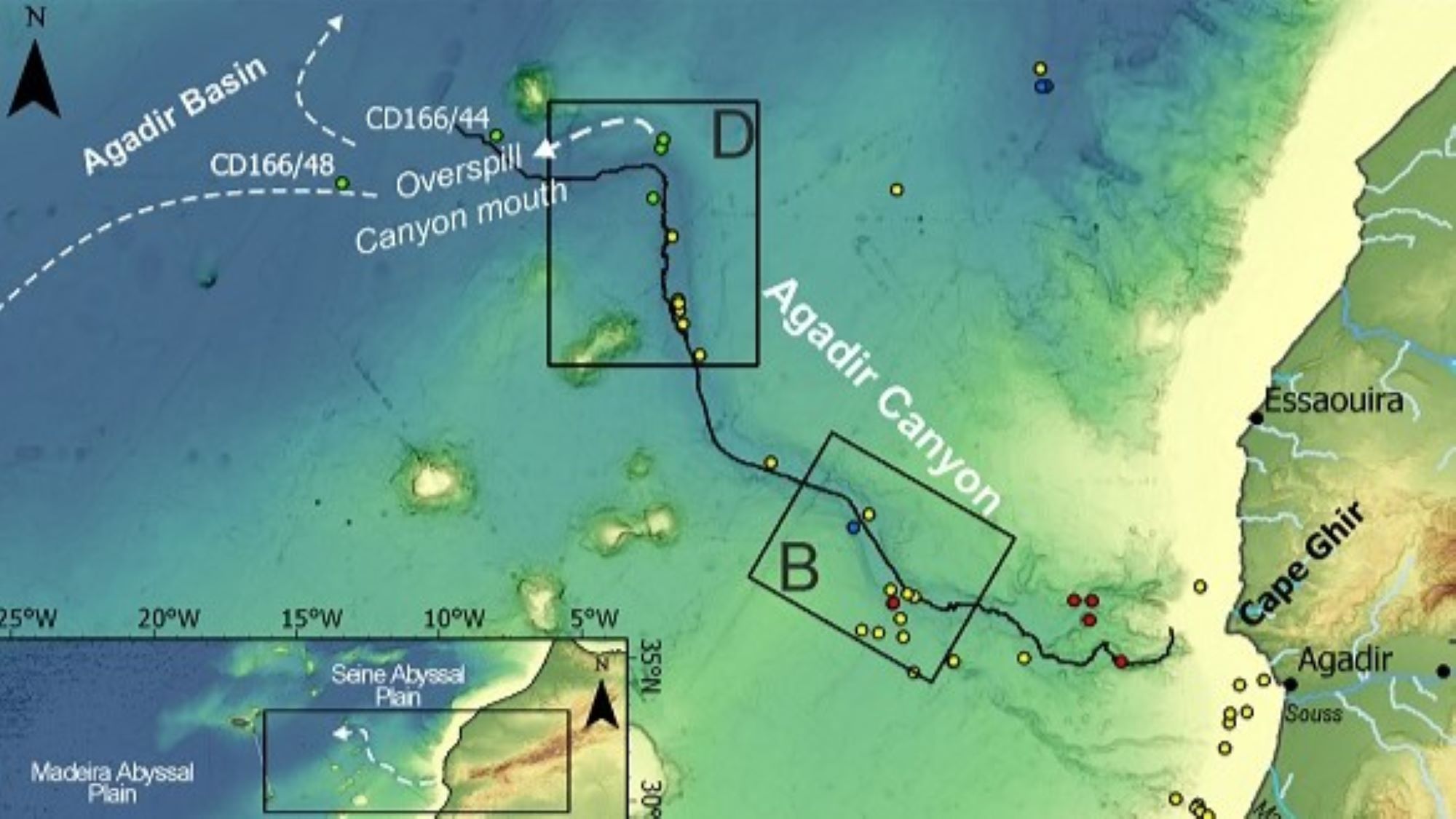2024-08-30 12:13:59
www.livescience.com
An underwater avalanche decimated a huge chunk of the East Atlantic seabed nearly 60,000 years ago, leaving behind an enormous trail of destruction.
The avalanche started as a small seafloor slide in the Agadir Canyon off the coast of Morocco, but it rapidly snowballed into a thunderous torrent of sediment and boulders, according to a new study.
A wave of mud, rocks and sand measuring 660 feet (200 meters) tall came crashing down through the canyon at speeds of 40 mph (65 km/h), “ripping out the seafloor and tearing everything out in its way,” study co-lead author Christopher Stevenson, a sedimentologist and lecturer at the University of Liverpool in the U.K., said in a statement. The avalanche tore through the 250-mile-long (400 kilometers) canyon before shooting out the other end and traveling another 1,000 miles (1,600 km) along the Atlantic seabed, Stevenson said.
All in all, the avalanche grew more than 100 times in size along its path, according to the study. That’s a huge growth factor compared with snow avalanches and debris flows on land, which grow four to eight times in size from start to end, co-lead author Christoph Böttner, a Marie-Curie researcher in geophysics and geology at Aarhus University in Denmark, said in the statement.
Massive inflation of this kind could be a defining characteristic of underwater avalanches, Böttner said. “We have also seen this extreme growth in smaller submarine avalanches measured elsewhere, so we think this might be a specific behavior associated with underwater avalanches,” he said.
The researchers used sediment data to retrace the path of the Agadir Canyon avalanche. They analyzed more than 300 core samples taken during research cruises over the past 40 years, as well as seismic and bathymetric (seabed topography) data from the area. By compiling this information, they created a map of the avalanche that shows its winding path inside and beyond the canyon. The team published its results Aug. 21 in the journal Science Advances.

“This is the first time anyone has managed to map out an entire individual underwater avalanche of this size,” Stevenson said. The map revealed that after the avalanche exited the canyon, it spread its load across an area roughly the size of Oregon, covering the seafloor in more than 3 feet (1 m) of sediment.
Underwater avalanches are extremely difficult to measure and often go unnoticed, but a modern-day equivalent to the Agadir Canyon catastrophe could potentially cause serious damage, the researchers said in the statement.
“These findings are of enormous importance for how we try and assess their potential geohazard risk to seafloor infrastructure,” study co-author Sebastian Krastel, a professor of marine geophysics and hydroacoustics at Kiel University in Germany, said in the statement. Things like internet cables, which carry the majority of global internet traffic, could suffer huge damage should another avalanche of this size strike again, Krastel said.
Source Link
Support Techcratic
If you find value in our blend of original insights (Techcratic articles and Techs Got To Eat), up-to-date daily curated articles, and the extensive technical work required to keep everything running smoothly, consider supporting Techcratic with Bitcoin. Your support helps me, as a solo operator, continue delivering high-quality content while managing all the technical aspects, from server maintenance to future updates and improvements. I am committed to continually enhancing the site and staying at the forefront of trends to provide the best possible experience. Your generosity and commitment are deeply appreciated. Thank you!
Bitcoin Address:
bc1qlszw7elx2qahjwvaryh0tkgg8y68enw30gpvge
Please verify this address before sending any funds to ensure your donation is directed correctly.
Bitcoin QR Code
Your contribution is vital in supporting my efforts to deliver valuable content and manage the technical aspects of the site. To donate, simply scan the QR code below. Your generosity allows me to keep providing insightful articles and maintaining the server infrastructure that supports them.

Privacy and Security Disclaimer
- No Personal Information Collected: We do not collect any personal information or transaction details when you make a donation via Bitcoin. The Bitcoin address provided is used solely for receiving donations.
- Data Privacy: We do not store or process any personal data related to your Bitcoin transactions. All transactions are processed directly through the Bitcoin network, ensuring your privacy.
- Security Measures: We utilize industry-standard security practices to protect our Bitcoin address and ensure that your donations are received securely. However, we encourage you to exercise caution and verify the address before sending funds.
- Contact Us: If you have any concerns or questions about our donation process, please contact us via the Techcratic Contact form. We are here to assist you.
Disclaimer: As an Amazon Associate, Techcratic may earn from qualifying purchases.


































![Canon DSLR Camera [EOS 90D] with 18-135 is USM Lens | Built-in Wi-Fi, Bluetooth, DIGIC 8…](https://techcratic.com/wp-content/uploads/2024/11/71wFDlXt6L._AC_SL1500_-360x180.jpg)

































